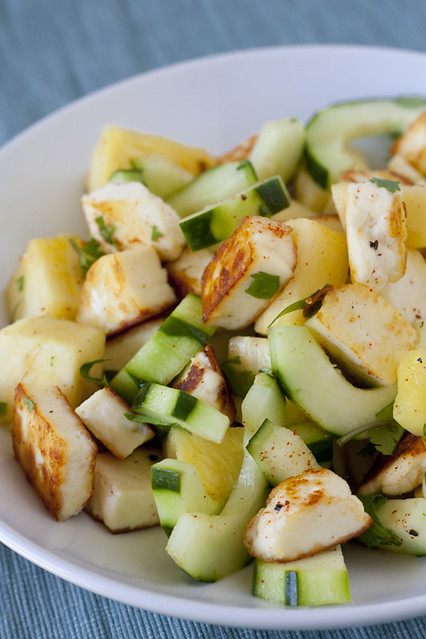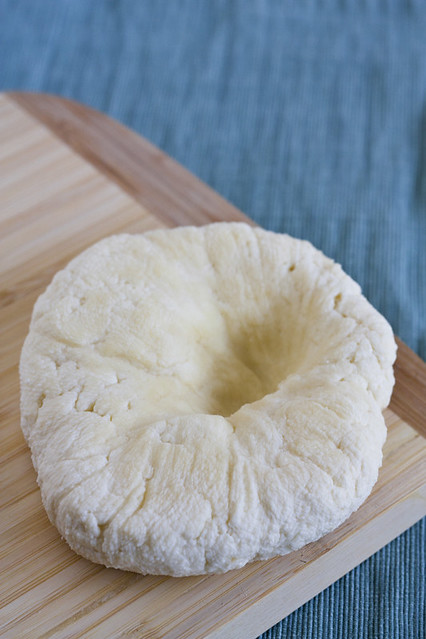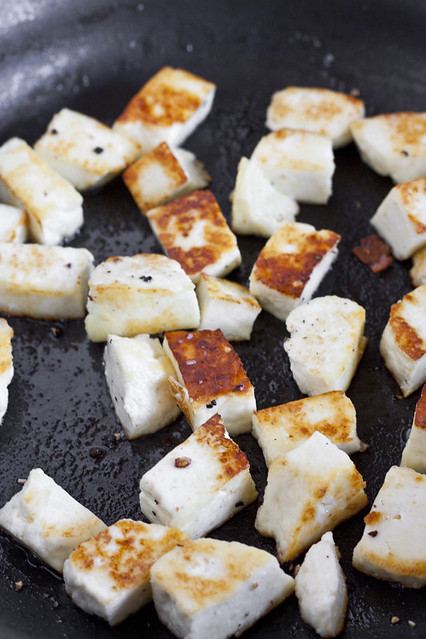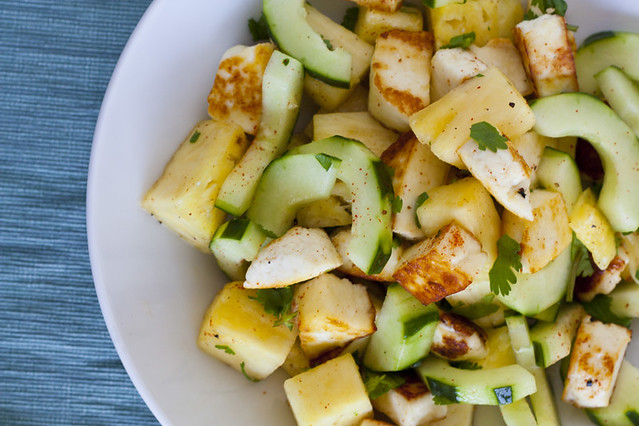
-Homemade cheese in a tropical Spring salad.-
“It’s squeaky!” I beamed.
BF paused his video game knowing that if he did not direct his attention to me I would get between him and the screen and ensure the death of his character. I grinned like a maniac and held out a seared piece of cheese prompting him to eat it. He surveyed the unidentifiable food the way a bomb team would inspect a mine field. He then considered me, possibly as crazy, and somewhat hesitantly pressed for more information, “What’s squeaky?”
“The paneer! It’s squeaky!”
My explanation being of no help he dropped his gaze back over to the paneer and studied it.
“It’s cheese. Please eat it. I just took it out of the fry pan and it is extremely hot,” I pushed.
He opened his mouth and I gingerly placed it on his tongue. With his first chew the cheese became audible as the pressed curds began to eek apart as if BF were masticating some terribly scared mice.
“See? Squeaky cheese.” It shouldn’t have been that thrilling or nearly as funny, but it was. I guess when you make your own cheese for the first time you can’t help but contract a dairy high from it.
The past year or so has been a whirlwind of cheese education for me. I’ve devoured any number of books and websites, and even more cheese all in the name of knowledge and whey (or so I say to justify eating an entire wheel of Petit Basque in a single sitting as if it were going to run away the second I stopped swallowing). At this point the science, the processes, and molds and bacterial cultures and the cheeses they're associated with no longer held any mystery. Each became identifiable and precise to me, and could be catalogued in memory and taste. I feel I can hold my own against many more knowledgeable cheese gurus.
However, there are still two things any cheese fiend still needs to do to be taken seriously by the Dairy World: visit a dairy and make cheese.

-The divot is there because I knotted the cheesecloth before pressing. The knot then pressed into the paneer. Lesson for you. Wrap and fold. Not wrap and knot.-
The former is something I keep meaning to do. I'll get right on it, soon. When I find time. Probably. The thing is that something inevitably pops up and bumps this task down the to-do list. Deadlines come up for old projects, research has to be done for new ones, studying, cooking, my attempts to revive the walking dead corpse that is my social life, and let's not forget familial guilt over my lack of visiting or calling are all vying for my unmitigated attention.
Believe me, I want to see happy goats and climate controlled caves lined with rounds of cheese stacked in so high they turn the room into a cultured Greek Parthenon. I want to put on plastic booties and a hairnet and see curds cut. My goal is to go home and curse out the washers at my apartment complex because they can’t get the primordial barnyard funk of so much cheese out of my clothes from touring a room of elderly blues.
Sadly, that will have to wait.
Anyways, making cheese is more doable and makes for a nifty weekend project.
Cheesemaking is one of those skills that many home cooks have lost. You see, cheese is more widely available than it ever has been and, really, there isn’t any practical need for people to know how to make their own cheese outside of personal satisfaction and cooking for cooking’s sake. Why go through the trouble of attempting your own Cheddar when Fiscalini produces a stalwart of the breed. Why raise goats when Laura Chenel has been doing such as damn fine job of it for the past 30+ years? (Plus, in my experience, goats can be total assholes. I've been butted a few times and lost a good flip-flop when a goat decided to make a snack out of it.) Making a blue at home is trying at best, but Whole Foods has a special on Bayley Hazen.
See where I’m going? Home cheesemaking isn’t a necessary skill. At least, not in the practical average American sense.

-Toasty cheese!-
But aren't knowledge and adventure reason enough to give it a go? The desire to better understand your obsession and master it is expected. Kids can memorize every minor detail about 650 pokemon. (Though this makes me wonder why our nation's test scores are so low?) Foragers carry books and sheets of white paper to do spore cap tests in order to identify poison mushroom from dinner mushroom. Coders learn C++ to make more engaging flash games, god bless them. Cheeseheads strain and press their own curds.
I decided to make paneer because it’s about as 101 as you can get for cheesemaking. Paneer is a simple cheese used in Indian cooking and usually made at home. It is also foolproof cheese. Simply heat some milk, pour in the vinegar, then stir, separate, and press. Congrats, you made paneer. It may sound like I’m breaking this down too much but I assure you that changing the oil in your car is more stressful and requires more experience than this.
The taste of uncooked paneer isn’t anything to swoon over. You won’t try it and wax poetics about it and you're unlikely to find it gracing a cheese plate. It tastes like concentrated milk, but, then again, that’s what it essentially is. Of course, the flavor also depends on the milk you’re using. You want to use a really high quality whole milk or top cream whole milk (the latter has more fat). If you use a milk that was made by cows who lived their lives roaming the country side eating grass and flowers and generally playing their happy cow games then it’ll taste better than milk from a factory cow who spent its life praying for a quick death that wasn’t going to happen.
Cook panner and it becomes an entirely different food. Sauteed in a bit of butter or oil the sugars and fats crisp and caramelize. The milk’s origins become loud and brilliant. The paneer takes on a toasty, wheaty flavor that soon submits to the taste of cream and clover. You realize the panner is just as excited as you when it meets your teeth with a cheerful squeak-squeak-squeak of appreciation.
Like other cheeses, paneer can also be flavored to give it character. Some people toss a thread of saffron into the milk as it cooks to impart a bitter flavor and Brahman color. Others mix in some freshly ground and toasted cumin or coriander into the curds before pressing. Cilantro or basil leaves can be wrapped around the paneer before its bundled and pressed in cheese cloth to impart a haunting grassy spice. It’s all up to the cook how to alter and flavor the paneer. Paneer, essentially, reflects the personality of the cook.
Unlike other cheeses, paneer is meant to be used as an ingredient and not as a stand alone cheese. It’s used in curries, wrapped in pastry and deep fried into fritters, sautéed with vegetable, marinated in chilies… paneer is essentially an everyday staple food used in a variety of dishes. It’s also a great food source for vegetarians looking to add some texture and unique flavor to their food. I’ve discovered that it’s also excellent in omelettes, tacos, and tossed in a pasta buried in a garlic-heavy tomato sauce.
This panner recipe is a simple one you can do any night of the week. I've personally found that paneer is fabulous in fresh salads. Tomatoes and greens are great, but tossing it with cucumber and pineapple is a fresh, spring-y salad perfect for warm weather.
Anywhose, give it a try. You'll love it. Even better? You can cross "learn to make cheese" off your list.

Paneer
Do not substitute anything for the whole milk. Cream will result in soft paneer and skim won't yield much of anything. Makes two cups of cubed cheese.
1/2 gallon whole milk
1/4 cup white vinegar
In a heavy-bottomed pot bring milk to a boil over medium-high heat. Slowly add the vinegar and stir. The curds and whey will separate. Pour into a stainer lined with cheesecloth (a thin tea towel could also work). Wrap up the curds tightly. Place in the sink and weight down with a cutting board topped with something heavy like a hefty cookbook or a kettle filled with water. Allow to drain for two hours. At this point you can use the paneer or wrap it in plastic wrap and store in the refrigerator for up to three days.
Paneer, Pineapple, Cucumber Salad
Serves 2-4
1 recipe paneer (see above)
1 tablespoon olive oil or butter
1/2 cucumber, peeled, seeded, and sliced
3 cups chopped pineapple
1/4 cup of cilantro, roughly chopped
juice of 2 limes
pinch cayenne
salt and pepper
1. Dice the paneer into bite-sized pieces. Set aside.
2. Place oil or butter in a pan over medium-high heat. Add paneer, lightly salt and pepper it, and sautee until lightly browned on all sides.
3. Toss together all ingredients. Taste and adjust spice and salt to taste. Serve.









How funny! It is squeaky, just like Haloumi.
ReplyDeleteI never thought of making it before, but it will be done this afternoon! I can't wait
Thanks for the inspiration!
You got me inspired to make my own cheese again! I used to make them every time I made homemade yogurt, but have been lazy ever since.
ReplyDeleteJust wondering though, have you found any uses for the whey that is strained off? I always find it such a waste to dump away all that liquid!
Since you say it's easier than changing the oil in my car, I guess I have to give this a go! I'd love to don a hairnet (preferably the opposite of my natural hair color for maximum effect) and booties over my red cowboy boots?? Bring it! All of the love of cheese!
ReplyDeleteFran: Anytime!
ReplyDeleteJanine: Some people save the whey for making bread, or give it to pets or livestock to drink.
DessertforTwo: It's super easy. You'll love it. Also, I want to see a photo of you in booties over cowboy boots. XD
I just made ricotta so now I'll try this. I love that we can make cheese out of what we already have in the house. What kind of vinegar did you use?
ReplyDeleteGarrett, thanks for another great post. The commentary on goats alone has made my day. I'll give this a shot over the weekend and try my hand at saag paneer.
ReplyDeleteQuestion - will any whole milk do, or will ultra-pasteurized milk give the same problem here as with yogurt?
ReplyDeleteStacey: I think you can use ultra-pasteurized. However, if you can find top cream, or unpasteruized that would be preferential.
ReplyDeleteSqueee! I've been wanting to try my hand at cheese-making and was considering either paneer or ricotta for my first attempt. Thanks for this.
ReplyDeleteOh, and the squeakiness of paneer is my favorite part too! Now I want some palak paneer...
The question is: will it work for poutine?
ReplyDeletetakes the flavours of curries really well, makes a nice light change from meats sometimes and just seems to work so well.
ReplyDeleteSuch a perfect introduction to cheese making. Makes me feel like the little engine that could: I think I can, I think I can.
ReplyDeleteThis looks fantastic! My goal is to make cheese this summer, and I think you have given me the inspiration. Beautiful! Thanks so much for this post.
ReplyDeleteI stumbled on your blog when googling fig ice cream, and have spent the last week reading your old posts. You've inspired me to get back in the kitchen and reclaim my love of cooking and baking, starting with spending the afternoon making Paneer. Thanks for your wit and charm, you have another loyal reader.
ReplyDeletedark: Thanks so much! So glad you enjoy the blog. =)
ReplyDeleteIts fun to make things from scratch :) Love squeaky cheese, the flavors in your salad sound DELICIOUS!
ReplyDeleteI've been wanting to make paneer, and I certainly will try your salad when I do! Looks scrumptious!! :)
ReplyDeleteHey, Just a tip instead of using vinegar you can use yoghurt to make your paneer, it doesnt leave that vinegary taste( especially if you're going to use it in a sweet recipe) and tastes better.
ReplyDeleteI loved reading your blog!
The paneer turns out even better if you use the whey left behind from previous paneer making exercises, to curdle the milk(instead of vinegar)
ReplyDelete